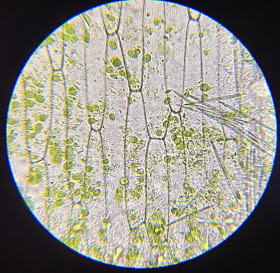We started this unit with an overview of cells: their structure and composition, and how they work. This was a bit of a review, since we talked about the structure of neurons quite a lot during our nervous system unit. It was interesting to see how, even though the basic parts are the same, the different types of cells in the body can look (and function) so different(ly) from each other! We just learned very briefly about what the organelles do, since that wasn't really the focus of this unit. We did get more in depth about the ribosomes and the nucleus later, as we talked about DNA replication and protein synthesis.
Skin cells at two levels of magnification
Leaf cells (not sure what kind of leaf it was) :)
We used some fountain pen ink to dye the onion skin cells, and that was cool. The cells are so neat and orderly! You can see how much structure the cell walls provide. And we were pleased to be able to see the nuclei so clearly with the ink dye.
Blood cells—a bit blurry
The blood cells were really interesting too. They were moving around right at first, but the blood dried quickly and then they didn't move. We only looked at blood in the first place because I accidentally cut myself on one of the microscope slides, but then it was so cool that we wished we could look at more of it. I tried to poke myself with a pin but no matter how hard I tried, I just couldn't draw blood! I wished I had one of those poker things they use for your finger when you go back donate blood. We didn't think we saw any white blood cells (although that might be one near the top right edge?), and we would have liked to find some, so we'll be looking for another opportunity next time someone gets hurt around here. :)







No comments:
Post a Comment